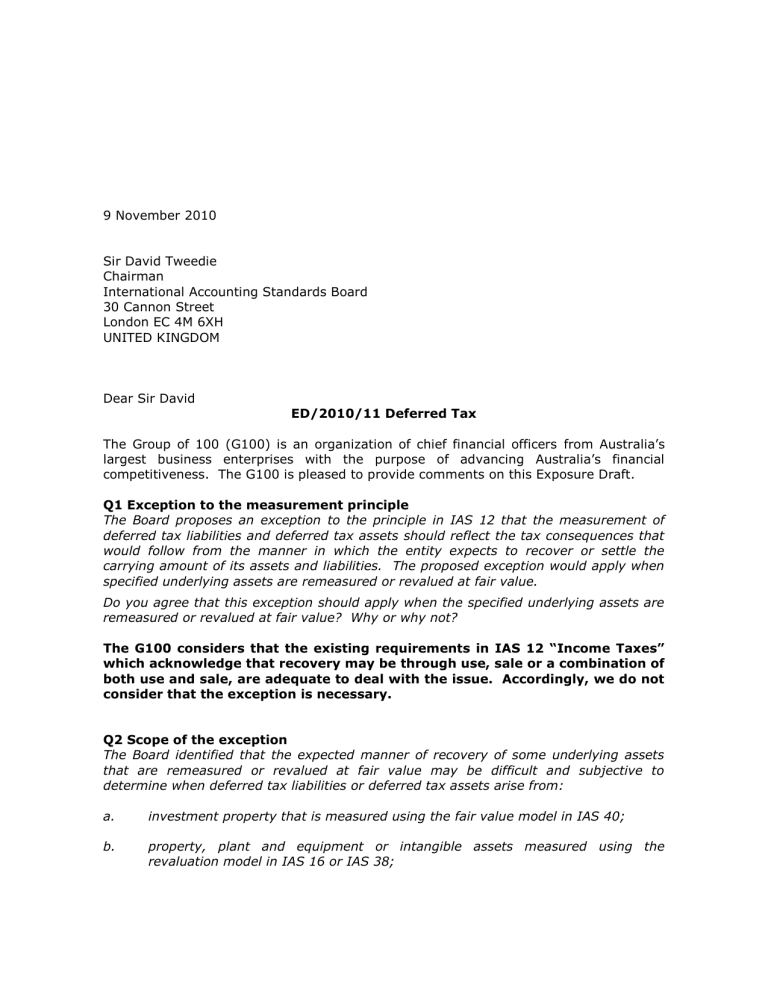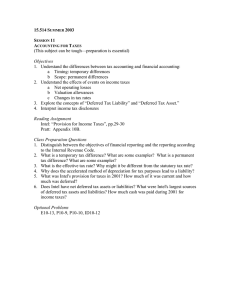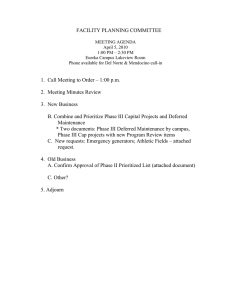CL65

9 November 2010
Sir David Tweedie
Chairman
International Accounting Standards Board
30 Cannon Street
London EC 4M 6XH
UNITED KINGDOM
Dear Sir David
ED/2010/11 Deferred Tax
The Group of 100 (G100) is an organization of chief financial officers from Australia’s largest business enterprises with the purpose of advancing Australia’s financial competitiveness. The G100 is pleased to provide comments on this Exposure Draft.
Q1 Exception to the measurement principle
The Board proposes an exception to the principle in IAS 12 that the measurement of deferred tax liabilities and deferred tax assets should reflect the tax consequences that would follow from the manner in which the entity expects to recover or settle the carrying amount of its assets and liabilities. The proposed exception would apply when specified underlying assets are remeasured or revalued at fair value.
Do you agree that this exception should apply when the specified underlying assets are remeasured or revalued at fair value? Why or why not?
The G100 considers that the existing requirements in IAS 12 “Income Taxes” which acknowledge that recovery may be through use, sale or a combination of both use and sale, are adequate to deal with the issue. Accordingly, we do not consider that the exception is necessary.
Q2 Scope of the exception
The Board identified that the expected manner of recovery of some underlying assets that are remeasured or revalued at fair value may be difficult and subjective to determine when deferred tax liabilities or deferred tax assets arise from: a. investment property that is measured using the fair value model in IAS 40; b. property, plant and equipment or intangible assets measured using the revaluation model in IAS 16 or IAS 38;
-2- c. investment property, property, plant and equipment or intangible assets initially measured at fair value in a business combination if the entity uses the fair value or revaluation model when subsequently measuring the underlying asset; and d. other underlying assets or liabilities that are measured at fair value or on a revaluation basis.
The Board proposes that the scope of the exception should include the underlying assets described in a, b, and c but not those assets or liabilities described in d.
Do you agree with the underlying assets included within the scope of the proposed exception?
Why or why not? If not, what changes to the scope do you propose and why?
As indicated above, the G100 considers that the principles in IAS 12 should continue to be applied. If there is insufficient clarity in IAS 12 the G100 believes that in a principles-based system it is more appropriate to provide guidance on its application than to create an exception.
Q3 Measurement basis used in the exception
The Board proposes that, when the exception applies, deferred tax liabilities and deferred tax assets should be measured by applying a rebuttable presumption that the carrying amount of the underlying asset will be recovered entirely through sale. This presumption would be rebutted only when an entity has clear evidence that it will consume the asset’s economic benefits throughout its economic life.
Do you agree with the rebuttable presumption that the carrying amount of the underlying assets will be recovered entirely by sale when the exception applies?
Why or why not? If not, what measurement basis do you propose and why?
The G100 does not believe that the introduction of the rebuttable presumption will result in improvements in practice. The requirement that there be clear evidence hinges on how that is interpreted in practice is likely to result in differences in application and does not remove subjectivity as to how the asset will be recovered. It is unclear whether entities holding infrastructure assets such as toll roads etc would be able to apply the exception because of the infrequency of sale transactions and their long lives.
Q4 Transition
The Board proposes that the amendments should apply retrospectively. This requirement includes retrospective restatement of all deferred tax liabilities or deferred tax assets within the scope of the proposed amendments, including those that were initially recognized in a business combination.
-3-
Do you agree with the retrospective application of the proposed amendments to IAS 12 to all deferred tax liabilities or deferred tax assets, including those that were recognized in a business combination?
Why or why not? If not, what transition method do you propose and why?
If the proposals proceed the transition requirements should be consistent with
IAS 8 ‘Accounting Policies, Changes in Estimates and Errors’.
Q5 Other comments
The G100 believes that the IASB should address the treatment of temporary differences in relation to goodwill. Where goodwill is deductible for tax purposes but amortization is not recognized under IFRSs there will be a full amortization for tax and a significant deferred tax liability recognized. In some circumstances it is unlikely that this deferred tax liability will crystallize into an actual payment of tax and it raises the issue as to whether this should be treated as a permanent difference.
Yours sincerely
Group of 100 Inc
Peter Lewis
President



